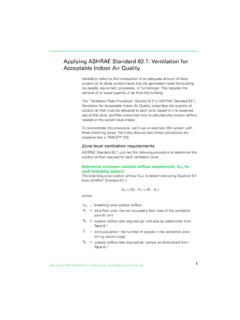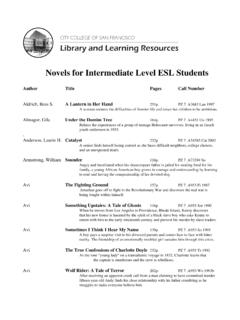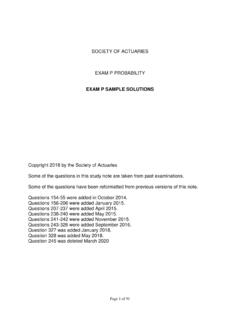Transcription of ASHRAE Guideline 36-2018
1 ASHRAE Guideline 36-2018 High-Performance Sequences of Operation for HVAC Guideline establishes a set of standardized advanced sequences of operation for common HVAC systems. Standardized advanced control sequences provide the following benefits: Reduced engineering time Reduced programming and commissioning time. Reduced energy consumption Title 24 Improved indoor air quality Reduced system down-time by including AFDD A common set of terms to facilitate communication between specifiers, contractors, and operators. The intended audience for the Guideline includes HVAC designers, control contractors, commissioning agents, and building owners, operators, and maintenance technicians. ASHRAE Guideline 36-2018 High-Performance Sequences of Operation for HVAC Systems Generic Ventilation & Thermal Zones Zone Groups VAV Terminal Unit Cooling Only VAV Terminal Unit with Reheat Parallel Fan-Powered Terminal Unit Constant-Volume Fan Parallel Fan-Powered Terminal Unit Variable-Volume Fan Series Fan-Powered Terminal Unit Constant-Volume Fan Series Fan-Powered Terminal Unit Variable-Volume Fan Dual-Duct VAV Terminal Unit Snap Acting Control Dual-Duct VAV Terminal Unit Mixing Control with Inlet Airflow Sensors Dual-Duct VAV Terminal Unit Mixing Control with Discharge Airflow Sensor Dual-Duct VAV Terminal Unit Cold-Duct Minimum Control Air-Handling Unit System Modes Multiple-Zone VAV Air-Handling Unit Dual-Fan Dual-Duct Heating VAV Air-Handling Unit Single-Zone VAV Air-Handling UnitLearning ObjectivesASHRAE Guideline 36-2018 High-Performance Sequences of Operation for HVAC SystemsA Review of sequences.
2 Control diagrams and required IO Points for: Assumptions: We all have a basic or general understanding / familiarity of control systems and termsLook at AFDD For AHU s and how Guideline 36 address barriers to entry for FDDSet Points Section 3 ASHRAE Guideline 36-2018 High-Performance Sequences of Operation for HVAC SystemsGeneral Observations General Move to Calculated or Dynamic Set Points over Static Set Points. IAQ is front and center Combines \ and Title 24 into a single reference pointExamples Economizer min spat min VFD Speed and min spat VFD Max Speed, VS a single economizer minimum position. CO2 SetpointGuidance Title 24, CO2setpoint = 600ppm + Ambient OA ppm (Assumed 400ppm if no sensor in place) , CO2setpoint = [Coa+8400 EzM/(Rp+(RaAz/Pz))] ( , assumes 400ppm OA) Max DAT = Ambient Temperature + 20 degF(ceiling supply systems)Set Points Section 3 Table , ASHRAE Guideline 36-2018 High-Performance Sequences of Operation for HVAC General GuidelinesASHRAE Guideline 36-2018 High-Performance Sequences of Operation for HVAC SystemsItems of note OA sensors at AHU s are only valid when the fan is proven On OA reading used for global sequences shall be the avgof all valid sensors, if there are 4 or more ignore the the highest and lowest reading.
3 PID Loop control, use only the P term for limiting loops(CO2, Zone Temperature, etc.) Do not use the D term on any loops if possible. Limit PID maximum change to 25%, make this a user modifiable variable. Alarm Exit Hysteresis Time based 5 seconds Analog includes Value % (Default is 0%) VAV Box Controllable Minimum Option 1 VAV stops moving damper when airflow is too low to low to register Option 2 Calculated Minimum Damper and Valve Positions (Needed) Hierarchical Alarm Suppression Time Based Suppression (Set Points) Trim and ResponseASHRAE Guideline 36-2018 High-Performance Sequences of Operation for HVAC SystemsA request is a call to reset a static pressure or temperature set point generated by downstream zones or air-handling systems. These requests are sent upstream to the plant or system that serves the zone or air handler that generated the request. Importance-Multiplier (default = 1) Request-Hours Accumulator System Run-Hours Total Cumulative%-Request-HoursInformative Figure Example sequence trend Trim and ResponseASHRAE Guideline 36-2018 High-Performance Sequences of Operation for HVAC -Generic Ventilation ASHRAE Guideline 36-2018 High-Performance Sequences of Operation for HVAC SystemsZone Air Distribution Effectiveness Ez DAT =< ZT Then Ez= 1 DAT > ZT Then Ez= Voz= (VbzA+ VbzP)/Ez VbzP= Population component VbzA= Ventilation Floor, Default 0 VbzP= 0 Window Switch = Open Occupancy Sensor = OffIf Co2 Sensor is present Vmin= 0% at Set Point 200ppm Vmin= 100% at Set Point Control Disabled if unoccupied or population = 0.
4 Time-Averaged Ventilation ASHRAE Guideline 36-2018 High-Performance Sequences of Operation for HVAC SystemsASHRAE Standard and California Title 24 allow for ventilation to be provided based on average conditions over a specific period of time. This time-averaging method allows for zone airflows to effectively be controlled to values below the VAV box controllable minimum value, which may reduce energy use and the risk of overcooling when the zone ventilation requirement is less than the VAV box controllable minimum. The time-averaged ventilation (TAV) ratio shall be deter-mined as TAVratio= Vspt/Vm The total cycle time (TCT) shall be 15 minutes (adjust-able) Open period. During the open period, the TAV airflow set point Vspt* shall be equal to Vmfor a period of time OP, which is the larger of the following: minutes or TCT multiplied by TAVratio Closed period. During the closed period, Vspt* shall be set to 0 for a period of time CP, where CP = TCT OP.
5 The VAV damper control loop shall be disabled with output set equal to 0 during the closed period. During TAV mode, each cycle shall consist of an open and closed period that alternate until Vsptis greater than Generic Thermal Zones ASHRAE Guideline 36-2018 High-Performance Sequences of Operation for HVAC SystemsItems of note Set Points Separate Occ/ Unoccset points Forced Deadbandof 1 DegFminimum Cooling Demand Limit & Set Point Adjustment Heating Demand Limit & Set Point Adjustment Control Loops Separate Loops \Disable when not active P+I loops Zone Groups ASHRAE Guideline 36-2018 High-Performance Sequences of Operation for HVAC SystemsZone scheduling groups, or zone groups, are sets of zones served by a single air handler that operate together for ease of scheduling and/or in order to ensure sufficient load to maintain stable operation in the upstream equipment. A zone group is equivalent to an isolation area as defined in ASHRAE /IES Standard 2016, Section of note Schedules by system Each Zone should be capable of being individually scheduled.
6 Testing and CX switches for each zone Operational Modes Occupied Warm-Up Cooldown Setback Freeze Protection Setup Unoccupied VAV Terminal Unit Cooling Only ASHRAE Guideline 36-2018 High-Performance Sequences of Operation for HVAC VAV Terminal Unit with ReheatASHRAE Guideline 36-2018 High-Performance Sequences of Operation for HVAC VAV Terminal Unit with ReheatASHRAE Guideline 36-2018 High-Performance Sequences of Operation for HVAC VAV Terminal Unit with ReheatASHRAE Guideline 36-2018 High-Performance Sequences of Operation for HVAC VAV Terminal Unit with ReheatASHRAE Guideline 36-2018 High-Performance Sequences of Operation for HVAC VAV Terminal Unit with ReheatASHRAE Guideline 36-2018 High-Performance Sequences of Operation for HVAC Parallel Fan-Powered Terminal Unit CV FanASHRAE Guideline 36-2018 High-Performance Sequences of Operation for HVAC Parallel Fan-Powered Terminal Unit CV FanASHRAE Guideline 36-2018 High-Performance Sequences of Operation for HVAC Parallel Fan-Powered Terminal Unit CV FanASHRAE Guideline 36-2018 High-Performance Sequences of Operation for HVAC Parallel Fan-Powered Terminal Unit V FanASHRAE Guideline 36-2018 High-Performance Sequences of Operation for HVAC Parallel Fan-Powered Terminal Unit V FanASHRAE Guideline 36-2018 High-Performance Sequences of Operation for HVAC Series Fan-Powered Terminal Unit CV FanASHRAE Guideline 36-2018 High-Performance Sequences of Operation for HVAC Series Fan-Powered Terminal Unit CV FanASHRAE Guideline 36-2018 High-Performance Sequences of Operation for HVAC Series Fan-Powered Terminal Unit V FanASHRAE Guideline 36-2018 High-Performance Sequences of Operation for HVAC Series Fan-Powered Terminal Unit V FanASHRAE Guideline 36-2018 High-Performance Sequences of Operation for HVAC Dual-Duct VAV Terminal Unit Snap Acting
7 ControlASHRAE Guideline 36-2018 High-Performance Sequences of Operation for HVAC Dual-Duct VAV Terminal Unit Snap Acting ControlASHRAE Guideline 36-2018 High-Performance Sequences of Operation for HVAC Dual-Duct VAV Terminal Unit Mixing Control with Inlet Airflow SensorsASHRAE Guideline 36-2018 High-Performance Sequences of Operation for HVAC Dual-Duct VAV Terminal Unit Mixing Control with Inlet Airflow SensorsASHRAE Guideline 36-2018 High-Performance Sequences of Operation for HVAC Dual-Duct VAV Terminal Unit Mixing Control with Discharge Airflow SensorASHRAE Guideline 36-2018 High-Performance Sequences of Operation for HVAC Dual-Duct VAV Terminal Unit Mixing Control with Discharge Airflow SensorASHRAE Guideline 36-2018 High-Performance Sequences of Operation for HVAC Dual-Duct VAV Terminal Unit Cold Duct Minimum ControlASHRAE Guideline 36-2018 High-Performance Sequences of Operation for HVAC Air-Handling Unit System ModesASHRAE Guideline 36-2018 High-Performance Sequences of Operation for HVAC SystemsMatch the Modes used by the Zone level terminal units.
8 Occupied Warm-Up Cooldown Setback Freeze Protection Setup Unoccupied Multiple Zone VAV AHUASHRAE Guideline 36-2018 High-Performance Sequences of Operation for HVAC Multiple Zone VAV AHUASHRAE Guideline 36-2018 High-Performance Sequences of Operation for HVAC Multiple Zone VAV AHUASHRAE Guideline 36-2018 High-Performance Sequences of Operation for HVAC Multiple Zone VAV AHUASHRAE Guideline 36-2018 High-Performance Sequences of Operation for HVAC Multiple Zone VAV AHUASHRAE Guideline 36-2018 High-Performance Sequences of Operation for HVAC Multiple Zone VAV AHUASHRAE Guideline 36-2018 High-Performance Sequences of Operation for HVAC Multiple Zone VAV AHUASHRAE Guideline 36-2018 High-Performance Sequences of Operation for HVAC Multiple Zone VAV AHUASHRAE Guideline 36-2018 High-Performance Sequences of Operation for HVAC Multiple Zone VAV AHUASHRAE Guideline 36-2018 High-Performance Sequences of Operation for HVAC Multiple Zone VAV AHUASHRAE Guideline 36-2018 High-Performance Sequences of Operation for HVAC Dual-Fan Dual-Duct Heating VAV Air-Handling UnitASHRAE Guideline 36-2018 High-Performance Sequences of Operation for HVAC Dual-Fan Dual-Duct Heating VAV Air-Handling UnitASHRAE Guideline 36-2018 High-Performance Sequences of Operation for HVAC Single-Zone VAV Air-Handling UnitASHRAE Guideline 36-2018 High-Performance Sequences of Operation for HVAC Single-Zone VAV Air-Handling UnitASHRAE Guideline 36-2018 High-Performance Sequences of Operation for HVAC Single-Zone VAV Air-Handling UnitASHRAE Guideline 36-2018 High-Performance Sequences of Operation for HVAC Single-Zone VAV Air-Handling UnitASHRAE Guideline 36-2018 High-Performance Sequences of Operation for HVAC Single-Zone VAV Air-Handling UnitASHRAE Guideline 36-2018 High-Performance Sequences of Operation for HVAC Single-Zone VAV Air-Handling
9 UnitASHRAE Guideline 36-2018 High-Performance Sequences of Operation for HVAC Single-Zone VAV Air-Handling UnitASHRAE Guideline 36-2018 High-Performance Sequences of Operation for HVAC Single-Zone VAV Air-Handling UnitASHRAE Guideline 36-2018 High-Performance Sequences of Operation for HVAC Single-Zone VAV Air-Handling Unit T&RASHRAE Guideline 36-2018 High-Performance Sequences of Operation for HVAC Single-Zone VAV Air-Handling Unit T&RASHRAE Guideline 36-2018 High-Performance Sequences of Operation for HVAC Single-Zone VAV Air-Handling Unit AFDDASHRAE Guideline 36-2018 High-Performance Sequences of Operation for HVAC SystemsRequired IORequired Calculated Single-Zone VAV Air-Handling Unit AFDDASHRAE Guideline 36-2018 High-Performance Sequences of Operation for HVAC Single-Zone VAV Air-Handling Unit AFDDASHRAE Guideline 36-2018 High-Performance Sequences of Operation for HVAC Single-Zone VAV Air-Handling Unit AFDDASHRAE Guideline 36-2018 High-Performance Sequences of Operation for HVAC Single-Zone VAV Air-Handling Unit AFDDASHRAE Guideline 36-2018 High-Performance Sequences of Operation for HVAC Single-Zone VAV Air-Handling Unit AFDDASHRAE Guideline 36-2018 High-Performance Sequences of Operation for HVAC Single-Zone VAV Air-Handling Unit AFDDASHRAE Guideline 36-2018 High-Performance Sequences of Operation for HVAC SystemsAFDD Barriers to EntryASHRAE Guideline 36-2018 High-Performance Sequences of Operation for HVAC SystemsVerifyReportsContinuousData Verification CollectingData DatabaseManagement Managing BASC onnectivity RuleGeneration PatchingMaking Changes/ImprovementsMeasure & VerifyChangesSetup & DataPipelineUpgrade EquipmentConfigure TrendsInstall JaceContextualizeDataQuestionsASHRAE Guideline 36-2018 High-Performance Sequences of Operation for HVAC SystemsThank YouBrice Kosnik




